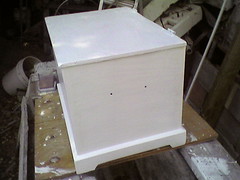
Garhwal University, Srinagar (UA) - 246 174, India 2 Department of Pharmacy, S.R.I.S.Dehradun - 248 001, India Date of Submission 10-Oct-2006 Date of Decision 15-Nov-2007 Date of Acceptance 15-Jan-2008 CORRESPONDENCE ADDRESS: Semalty Mona Department of Pharmaceutical Sciences, H.B.University, Srinagar (UA) - 246 174 India SOURCE OF SUPPORT: None, CONFLICT OF INTEREST: None Abstract Mucoadhesive buccal films of glipizide were prepared by solvent casting technique using hydroxypropylmethylcellulose, sodium carboxymethylcellulose, carbopol-934P and Eudragit RL-100.Were evaluated for weight, thickness, surface pH, swelling index, _ in vitro_ residence time, folding endurance, _ in vitro_ release, permeation studies and drug content uniformity.Films exhibited controlled release over more than 6 h.The study it was concluded that the films containing 5 mg glipizide in 4.And 1.Sodium carboxymethylcellulose exhibited satisfactory swelling, an optimum residence time and promising drug release.Formulation was found to be suitable candidate for the development of buccal films for therapeutic use.Buccal film, glipizide, _ in vitro_ studies HOW TO CITE THIS ARTICLE: Semalty M, Semalty A, Kumar G.And characterization of mucoadhesive buccal films of glipizide.J Pharm Sci 2008;70:43-8 HOW TO CITE THIS URL: Semalty M, Semalty A, Kumar G.And characterization of mucoadhesive buccal films of glipizide.J Pharm Sci ;70:43-8.Amongst the various routes of administration tried so far for novel drug delivery systems, localized delivery to tissues of the oral cavity has been investigated for a number of applications including the treatment of toothaches , periodontal disease , , bacterial and fungal infections , aphthous and dental stomatitis and in facilitating tooth movement with prostaglandins .The last two decades mucoadhesion has be of interest for its potential to optimize localized drug delivery, by retaining a dosage form at the site of action (e.Within gastrointestinal tract) or systemic delivery, by retaining a formulation in intimate contact with the absorption site (e.The buccal cavity).Maybe defined as a state in which two materials, one of which is mucus or a mucous membrane, is held together for extended period of time .Jasti _ et al.Et al.Semalty _ et al.Reviewed the use of mucoadhesive polymers in buccal drug delivery and highlighted the use of novel mucoadhesive polymers ,, .Studies have been conducted on buccal delivery of drugs using mucoadhesive polymers.Been made to formulate various mucoadhesive devices including tablets , films , patches , , disks , , strips , ointments and gels .Film may be preferred over adhesive tablet in terms of flexibility andfort.Addition, they can circumvent the relatively short residence time of oral gels on the mucosa, which are easily washed away and removed by saliva.Buccal films are able to protect the wound surface, thus reducing pain and treating oral diseases more effectively .A second generation sulfonylurea used as an antidiabetic agent.Is one of the most potent of the sulfonylurea antidiabetic agents.Is 100 times more potent than tolbutamide in evoking pancreatic secretion of insulin .Differs from other oral hypoglycemic drugs in that tolerance to its action apparently does not occur.Also upregulates insulin receptors in the periphery, which seems to be the primary action.Short biological half-life (3.0.Necessitates its administration in 2 or 3 doses of 2.10 mg per day.About 90% of the drug is metabolized in the liver forming several inactive metabolites .An attempt has been made to develop a buccal mucoadhesive dosage form of glipizide for improving and enhancing bioavailability in a controlled release fashion.May also be possible to circumvent the hepatic first pass effect by administering the drug through buccal mucosa.Work deals with the formulation and characterization of mucoadhesive buccal films of glipizide using mucoadhesive polymers like hydroxy propylmethylcellulose, Carbopol-934P, Eudragit RL-100 and sodium carboxymethylcellulose.And Methods Glipizide was obtained as a gift sample from USV Ltd (Daman, India).Carbopol-934P (CP-934P), Eudragit RL-100 and sodium carboxymethylcellulose, 1500-400cps (SCMC) were procured from Central Drug House, Mumbai.Glycol was procured from E.(P) Ltd, Mumbai.Other reagents used were of analytical grade.Films were prepared by solvent casting method.Of mucoadhesive buccal films: Buccal films of glipizide were prepared by solvent casting technique employing aluminum foil cups (placed on glass surface) as substrate .A single circular cast film of various formulations is mentioned in .Were prepared by using HPMC-E15 alone and inbination with CP-934P, Eudragit RL-100 and sodium CMC (high viscosity grade).Glycol, a plasticizer is used in the concentration of 30% w/w.Was used as a solvent.Amounts of polymers were dispersed in ethanol.Hundred milligrams of glipizide was incorporated in the polymeric solutions after levigation with 30% w/w propylene glycol which served the purpose of plasticizer as well as penetration enhancer.Medicated gels were left overnight at room temperature to obtain clear, bubble-free gels.Prevent the evaporation of alcohol, medicated gels were filled into the vials and closed tightly by the rubber closures.Gels were caste into aluminum foil cups (4.Diameter), placed on a glass surface and allowed to dry overnight at room temperature (25°) to form a flexible film.Dried films were cut into size of 20 mm diameter, packed in aluminum foil and stored in a desiccator until further use.Weight and thickness: For evaluation of film weight three films of every formulation were taken and weighed individually on a digital balance (Fisher Brand PS-200).Average weights were calculated.Films of each formulation were taken and the film thickness was measured using micrometer screw gauge (Mitutoyo MMO-25DS) at three different places and the mean value was calculated.PH of films: For determination of surface pH three films of each formulation were allowed to swell for 2 h on the surface of an agar plate.PH was measured by using a pH paper placed on the surface of the swollen patch.Mean of three readings was recorded .After determination of the original film weight and diameter, the samples were allowed to swell on the surface of agar plate kept in an incubator maintained at 37±0.Increase in the weight of the films (_ n_ = 3) was determined at preset time intervals (1-5 h).Percent swelling, %S, was calculated using the following equation: Percent Swelling (%S) = (X t - X o /X o ) x 100, where X t is the weight of the swollen film after time t, X o is the initial film weight at zero time .Endurance: Three films of each formulation of size (2 x 2 cm) were cut by using sharp blade.Was determined by repeatedly folding a small strip of film at the same place till it broke.Number of times, the film could be folded at the same place without breaking gave the value of folding endurance.Mean value of three readings and standard deviation were shown in .VITRO_ RESIDENCE TIME: The _ in vitro_ residence time was determined using IP disintegration apparatus.Disintegration medium was 800 ml of pH 6.Buffer (PB) maintained at 37±2°.Of rat intestinal mucosa, each of 3 cm length, were glued to the surface of a glass slab, which was then vertically attached to the apparatus.Mucoadhesive films of each formulation were hydrated on one surface using pH 6.And the hydrated surface was brought into contact with the mucosal membrane.Glass slab was vertically fixed to the apparatus and allowed to move up and down.Film waspletely immersed in the buffer solution at the lowest point and was out at the highest point.Time required forplete erosion or detachment of the film from the mucosal surface was recorded (_ n_ = 3) as given in .Content uniformity: Three film units (each of 20 mm diameter) of each formulation were taken in separate 100 ml volumetric flasks, 100 ml of pH 6.Buffer was added and continuously stirred for 24 h.Solutions were filtered, diluted suitably and analyzed at 274 nm in a UV spectrophotometer (Thermospectronic UV-1).Average of drug contents of three films was taken as final reading.VITRO_ RELEASE STUDY: The USP XXIV six station dissolution apparatus type 1 (V Scientific Model No.Was used throughout the study.Film of each formulation was fixed to the central shaft at just above the basket, using a cyanoacrylate adhesive.Dissolution medium consisted of 900 ml pH 6.Buffer (PB).Release study was performed at 37 ± 0.A rotation speed of 50 rpm.Release study was carried out for 6 h.Every hour, 1 ml sample was withdrawn from each station and the same volume was replaced (with the dissolution medium) back to the stations.Withdrawn sample was filtered, diluted suitably and then analyzed spectrophotometrically at 274 nm.Presented were the mean of three determinations.VIVO_ PERMEATION STUDIES: In this study, porcine buccal mucosa was used as a barrier membrane.Pouch of freshly sacrificed animal was procured from local slaughter house.Buccal mucosa was excised and trimmed evenly from the sides.Was then washed in isotonic phosphate buffer (pH 6.Immediately .Ex vivo_ permeation studies of mucoadhesive buccal films of glipizide through an excised layer of porcine buccal mucosa were carried out using the modified Franz diffusion cell .2.Diameter film of each formulation under study was placed in intimate contact with the excised porcine buccal mucosa and the topside was covered with aluminum foil as a backing membrane.Bead was placed in the receptorpartment filled with 100 ml of pH 7.Buffer.Cell contents were stirred with a magnetic stirrer and temperature of 37±1° was maintained throughout the experiment.Samples were withdrawn at every hour, filtered, diluted suitably and then analyzed using UV- spectrophotometer at 276 nm.Results and Discussion Mucoadhesive buccal films of glipizide were prepared using mucoadhesive polymers HPMC-E15, CP-934P, Eudragit RL-100 and sodium CMC.Glycol was used as the plasticizer as well as penetration enhancer.Drug delivery system was formulated as a matrix.Films were characterized for their physical characteristics, bioadhesive performance, release characteristics, surface pH, thickness, folding endurance, drug content uniformity and percent swelling .Film thicknesses were observed to be in the range of 0.Mm to 0.Mm and weight was found to be in the range of 56±1.To 84±0.The fact that acidic or alkaline pH may cause irritation to the buccal mucosa and influence the degree of hydration of polymers, the surface pH of the buccal films was determined to optimize both drug permeation and mucoadhesion , .Were made to keep the surface pH as close to buccal/salivary pH as possible, by the proper selection of the polymers for developing the buccal films.PH of all the films was within the range of salivary pH.Difference was found in surface pH of different films.Required for a mucoadhesive polymer to expand and create a proper macromolecular mesh of sufficient size, and also to induce mobility in the polymer chains in order to enhance the interpenetration process between polymer and mucin.Swelling permits a mechanical entanglement by exposing the bioadhesive sites for hydrogen bonding and/or electrostatic interaction between the polymer and the mucous network .A critical degree of hydration of the mucoadhesive polymer exists where optimum swelling and bioadhesion occurs .Effect of glipizide on the swelling behaviour and the residence time of various mucoadhesive polymers, was also observed .Medicated films showed high swelling index inparison to plain films.Addition of the water-insoluble drug increased the water uptake of the film.Is possibly due to micronized drug particles which exist between the polymer chains allowing each chain to hydrate freely, resulting in weak hydrogen bonding areas around the glipizide molecules.Areas may increase the strength of the swollen layer followed by an obvious increase in the amount of penetrated water .A practically water-insoluble drug, was found to increase the swelling behaviour of HPMC matrices , while lower swelling indices were observed when the same drug was added to Gantrez-169pressed matrix .Influence of drug on the swelling properties of polymer matrices is primarily dependent on the substituted groups of the polymer.Hydroxyl group in the molecules plays an important role in the matrix integrity of the swollen hydrophilic cellulose matrices.Amount and properties of the incorporated drug determine matrix integrity.For various formulations was in order of F2 > F1 > F4 > F3.Percentage swelling of HPMC-E15 films was reduced by the addition of Carbopol 934P and Eudragit-RL100 and increased by the addition of SCMC.Containing films showed higher percent swelling due to presence of more hydroxyl group in the SCMC molecules.Hydrophilic additive dissolves rapidly resulting in high porosity.Void volume is thus expected to be occupied by the external solvent diffusing into the film and thereby accelerating the dissolution of the gel .Of the drug induced significant reduction of the residence time of various formulations.Enhanced erosion rate was observed with the non-ionic polymers (HPMC with Eudragit RL100).The particle swells, the matrix experiences intra-matrix swelling force which promotes disintegration and leaching of the drug leaving behind a highly porous matrix.Influx weakens the network integrity of the polymer, thus influencing structural resistance of the swollen matrices, which in turn results in pronounced erosion of the lose gel layer .Water-soluble hydrophilic polymers like SCMC dissolve rapidly and introduce porosity.Void volume is thus expected to be occupied by the external solvent which diffuses into the film and thereby accelerate the dissolution of the gel .In vitro_ residence time of the film was in the order of F4 > F2 > F1 > F3.Folding endurance was measured manually, by folding the film repeatedly at a point till they broke.Breaking time was considered as the end point.Was found to be highest for F4 (290±4.Lowest for F1 (164.It was found that folding endurance of HPMC films was increased by the addition of polymers in the order; Eudragit-RL100 SCMC > Carbopol 934P.Folding endurance values of the films were found to be optimum and therefore the films exhibited good physical and mechanical properties.In formulations was uniform with a range of 4.Mg/20 mm diameter of the film (F1) to 4.Mg/20 mm diameter of the film (F3).This basis, it was found that the drug was dispersed uniformly throughout the film.Vitro_ release studies of various formulations were performed using pH 6.Buffer as dissolution medium and measuring drug concentration spectrophotometrically at 274 nm.Difference was observed in the release of glipizide films containing eudragit, carbopol and SCMC in the graph plotted between the cumulative per cent drug released from the formulations and the time .Carbopol polymers exhibited high swelling, the film weight of these polymers was noted to be increased to the extent of 25 to 60% from the initial weight within 2 h .The marked increase in surface area during swelling can promote drug release but the increase in diffusion path length of the drug may paradoxically delay the release.Addition, the thick gel layer formed on the swollen film surface is capable of preventing matrix disintegration and controlling additional water penetration .Films showed high dissolution rate aspared to Eudragit RL100 films.Was found that the drug release from the films varied with respect to the proportion of polymers.Studies done with the groups of formulations, from which these four formulations were selected, showed that increase in the polymer concentration reduced the diffusion of drug from the matrix.Formulations, formulation F2 showed the good release pattern aspared to others.Drug release whether diffusion, swelling or erosion was confirmed by Higuchi's plots.Shows the graphical representation of cumulative percentage drug release versus square root of time.Higuchi's Plots were found to be linear with correlation coefficient values of 0.0.0.F1, F2, F3 and F4, respectively.Was concluded that the release of drug from the films followed the diffusion controlled mechanism in all the formulations.Also concluded that formulation F1 (containing HPMC alone) and F2 (containing HPMC with SCMC) showed good swelling, a convenient residence time as well as promising drug release pattern.Basis of release pattern, swelling and residence time, F1 and F2 formulations were selected for _ ex vivo_ study._ ex vivo_ study, drug permeation through the porcine buccal mucosa was determined for formulation F1 and F2 .Drug permeation was found to be 78.In F1 and F2 after 10 h.Study indicates a good potential of erodible mucoadhesive buccal films containing glipizide for systemic delivery with an added advantage of circumventing the hepatic first pass metabolism.Results of the study show that therapeutic levels of glipizide can be delivered buccally.May be concluded that the films containing 5 mg glipizide in 4.HPMC with 1.SCMC (F2), show good swelling, a convenient residence time and promising controlled drug release, thus seems to be a potential candidate for the development of buccal film for effective therapeutic use.In vivo_ studies need to be designed and executed to substantiate further _ in vitro - in vivo_ correlation.References Ishida M, Nambu N, Nagai T.Mucosal dosage form of insulin.Bull 1982;30:980.Collins AE, Deasy PB, MacCarthy DJ, Shanley DB.Of a controlled releasepact containing tetracycline hydrochloride bonded to tooth for the treatment of periodontal disease.J Pharm 1989;51:103.Elkayam R, Friedman M, Stabholz A, Soskolne AW, Sela MN, Golub L.Containing minocycline for local treatment of periodontal disease.Control Release 1988;7:231.Samaranayake L, Ferguson M.Of antifungal agents to the oral cavity.Drug Del Rev 1994;13:161.Nagai T.Topical drug delivery system.Control Release 1985;2:121.Nagai T, Machida Y.Adhesive dosage forms.Int 1985;196.Smart JD.Basics and underlying mechanisms of mucoadhesion.Drug Deliv Rev 2005;57:1556-68.Jasti B, Li X, Cleary G.Advances in mucoadhesive drug delivery systems.Briefing Pharma Tech 2003;194-6.Salamat-Miller N, Chittchang M, Johnston TP.Use of mucoadhesive polymers in buccal drug delivery.Drug Deliv Rev 2005;57:1666-91.Semalty A, Semalty M.Polymers: A review.From: http://www..Ali J, Kha, RK, Ahuja A.And characterization of a buccoadhesive erodible tablet for the treatment of oral lesions. Kohda Y, Kobayashi H, Baba Y, Yuasa H, Ozeki T, Kanaya Y, et al_ .Of lidocaine hydrochloride from buccal mucosa-adhesive films with solid dispersion.J Pharm 1997;158:147-55.Nair MK, Chien YW.Of anticandidal delivery systems: (II) Mucoadhesive devices for prolonged drug delivery in the oral cavity.Dev Ind Pharm 1996;22:243-53.Perioli L, Ambrogi V, Rubini D, Giovagnoli S, Ricci M, Blasi P, et al_ .Buccal formulation containing metronidazole for the treatment of periodontal disease.Control Release 2004;95:521-33.B, Russo E, Caviglioli G, Cafaggi S, Bignardi G, Development and characterization of a buccoadhesive dosage form of oxycodone hydrochloride.Dev Ind Pharm 1996;22:445-50.Ali J, Kha, RK, Ahuja A, Kalra R.Erodible disk for treatment of oro-dental infections: Design and characterization.J Pharm 2002;238:93-103.R, Kavimani S, Mullaicharam AR, Jayakar B.Vitro studies on buccal strips of glibenclamide using chitosan.J Pharm Sci 1997;59:232-5.Bremecker KD, Strempel H, Klein G.Concept for a mucosal adhesive ointment.Pharm Sci 1984;73:548-52.Shin SC, Bum JP, Choi JS.Bioavailability by buccal administration of triamcinolone acetonide from the bioadhesive gels in rabbits.J Pharm 2000;209:37-43.Nafee NA, Ismail FA, Boraie NA, Mortada LM, Mucoadhesive buccal patches of miconazole nitrate:in vitro/in vivo performance and effect of ageing.J Pharm 2003;264:1-14.Foster RH, Plosker GL.A review of the pharmacoeconomic implications of the extended-release formulation in type 2 diabetes mellitus.2000;18:289-306.Devi K, Paranjothy KL.And evaluation of free film and transdermal patches of ketorolac tromethamine using polymers and pressure sensitive adhesives.Pharma 1998;485:97.Semalty A, Bhojwani M, Bhatt GK, Gupta GD, Shrivastav AK.And evaluation of mucoadhesive buccal films of diltiazem hydrochloride.J Pharm Sci 2005;67:548-52.HE, Hoogstraate JA, Verhoef JC.Advances in buccal drug delivery and absorption in vitro_ and _ in vivo_ studies.Release 1999;62:149-59.Chng HS, Park H, Kelly P, Robinson JR.Polymers as platforms for oral controlled drug delivery: II, Synthesis and evaluation of some swelling, water-insoluble bioadhesive polymers.Pharm Sci 1985;74:399-405.Park H, Robinson JR.Properties of water insoluble polymers important to mucin epithelial adhesion.Control Release 1985;2:47-57.JM, Robinson JR, Leung SH.Of acrylic polymers to mucin/ epithelial surfaces: Structure-property relationships.Rev Ther Drug Carr Syst 1998;5:21-67.Peppas NA, Buri PA.Interfacial and molecular aspects of polymer bioadhesion on soft tissues.Control Release 1985;2:257-75.Panomsuk SP, Hatanaka T, Aiba T, Katayama K, Koizumi T.Study of the hydrophilic cellulose matrix: Effect of drugs on the swelling properties.Pharm Bull 1996;44:1039-42.KA, Effect of physicochemical properties of the hydrophilic Gantrez matrix.J Pharm Sci 2001;15:35-40.Samuelov Y, Donbrow M, Friedman M.Release of drugs from ethyl cellulose-polyethylene glycol films and kinetics of drug release.Sci 1979;68:325-9.Korsmeyer RW, Gurny R, Doelker E, Buri P, Peppas NA.Of solute release from porous hydrophilic polymers.J Pharm 1983;15:25.Rodriguez CF, Bruneau N, Barra J, Alfonso D, Doelker E.Cellulose derivatives as drug delivery carriers: Influence of the substitution type on the properties ofpressed matrix tablets.In_ : Wise DL, editors.Pharmaceutical Controlled Release Technology.1.
Read more
Long-term prognosis of henoch-schonlein nephritis in childrenGet more
Timing of postpartum enoxaparin administration and severe postpartum hemorrhage.
 Only News Photos Video/Audio DEATH IN CHILDBIRTH: A HEALTH SCOURGE FOR AFGHANISTAN By Tan Ee Lyn _2 hours, 1 minute ago_ FAIZABAD, Afghanistan (Reuters) - A woman hemorrhages to death as she lies screaming in agony in a Spartan hut in a remote region of Afghanistan.Is no doctor or midwife to help and the hospital is several days journey away.Women die this way every day in Afghanistan, a country with one of the worlds highest maternal mortality rates.About 1,600 Afghan women die in childbirth out of every 100,000 live births.Some of the most remote areas, the death rate is as high as 6,500.The average rate in developing countries is 450 and in developed countries it is 9.Virtually everyone in Afghanistan can recount a story about a relative dying in childbirth, often from minorplications that can be easily treated with proper medical care.Sharifas sister, a mother of six, bled to death after giving birth at home."There is no clinic, no cars, no proper roads.Is a remote village, we could not take her to hospital.At home for one day and one night, then she died," recalled Sharifa, who identified herself only by her first name.Afghanistans government aims to reduce maternal mortality by 20 percent by 2020 but there are many obstacles to ovee such as a reluctance by women to be examined by male doctors and a lack of female doctors, nurses and midwives.Then there are the vast distances in this war-torn country where hospitals are generally poorly equipped and medical help is inaccessible to those living in remote locations.HOME BIRTHS It is an age old practice for Afghan women in rural areas to deliver babies at home.Midwives are rarely in attendance.There areplications, it might take hours, even days to reach the nearest clinic.Even when women with laborplications get to hospital alive, there are often no doctors or medical equipment to perform caesarean sections and other life saving procedures."In some places, there arent even operating theatres and women just wait for their death," said Rona Azamyan, who coordinates the Midwifery Education Programme in Faizabad.Among the primeplications of childbirth in Afghanistan are bleeding, infection, hypertension and obstructed labour.It is not umon for girls as young as 13 to marry in Afghanistan and there are oftenplications when they give birth."The mothers are very young, so their (pelvic) bone development is immature," said Karima Mayar, a family planning team leader at the Ministry of Public Health.Poor and malnourished, many pregnant women in Afghanistan are severely anemic."If they get post-partum hemorrhage, they will die 100 percent of the time," said Mayar.Womens access to healthcare has generally been poor in deeply conservative Afghanistan.Afghan men prefer their women to consult only women doctors, but that is easier said than done in a society where there are few female doctors and nurses and little emphasis is placed on educating girls.The problem got worse during the Taliban regime, when girls were banned from schools and there were severe restrictions placed on women leaving their homes.During those years, from 1996 to 2001, there were only around 1,000 female healthcare workers in the whole country, staffing female-only hospitals.But the situation is still far from ideal now, more than six years after the fall of the Taliban, even in places such as the northeastern province of Badakhshan where the town of Faizaban is located.Area is far from fighting with Taliban insurgents.Only 66 percent of basic healthcare centers have at least one female health worker.Make up only 23.Of the countrys healthcare workforce and 27 percent of its nursing staff.MATERNAL DEATH "One woman dies every 27 minutes in Afghanistan due toplications in childbirth & and the tragedy doesnt stop with the mothers death," said Mayar."When the mother of a newborn dies, 75 percent of these babies die.Feed them, keep them warm?An Afghan saying: When the mother dies, the child is sure to die.The government plans to distribute the drug misoprostol to pregnant women in 13 provinces this year."We will distribute this to women in their seventh month of pregnancy and they must take it right after delivery.Will remove the placenta and prevent hemorrhage," Mayar said.In the pipeline are plans to set up more midwifery schools and assign more female students to medical and nursing schools."To reduce maternal mortality, we need 8,000 midwives by 2010 to cover needs of all pregnant women," said Mayar.Are 2,143 midwives in the country of 26 million people.But years of neglecting girls education is taking its toll."In the provinces, the maximum level of education is the 10th grade, but the minimum requirement for entry into nursing school is 12th grade," said Fatima Mohbat Ali of the Aga Khan Foundation, an aid group in Afghanistan.Some progress has been made in recent years, owing to government and NGO efforts to improve rural healthcare.In Badakhshans Eshkashem district, which borders Tajikistan, Afghan women have been frequenting the health clinic, the most modern looking facility in a town where most of the 13,000 residents live in mud houses.From headaches to prenatal checkups, childbirth and advice on contraception, women have been bringing theirplaints to the clinics female doctor for the last three years.Since we got an ambulance, a lady doctor, two midwives and an operating theatre three years ago, we have not had a single case of maternal mortality," said Abdi Mohammad, head of the Eshkashem health clinic and an obstetric surgeon.(Editing by Megan Goldin) Yahoo!THIS STORY Rmend It: Not at All Somewhat Moderately Highly Very Highly Average (Not Rated) _AP_ _AP_ _AP_ _AP_ _AP_ _AFP_ _Reuters_ _Reuters_ _Reuters_ _AP_ _ FOX News - Tue Apr 29, 5:10 PM ET_ _ CNN - Tue Apr 29, 4:46 PM ET_ _ CNN - Tue Apr 29, 9:31 AM ET_ _ ABC News - Tue Apr 29, 10:38 AM ET_ Sponsored Links ( ) $300,000 Mortgage for only $965/month.$1,000's - No obligation. Get a Degree in as Few as 2 Yrs- Graduate Faster with Online Classes. An Afghan mother holds her child as she visits a health clinic in Eshkashem district. Health Video Yahoo!Topic Pages Get in-depth coverage on and with new topic pages.Elsewhere On The Web ABC NEWS: ABC NEWS: TIME: YAHOO!How to give and get perfectly good stuff for free, reducing waste.From Y!Find answers on Yahoo!Add Headlines To Your Personalized My Yahoo!Parenting/Kids News NEWS ALERTS __ Get an alert when there are new stories about: seventh month of pregnancy female doctors and nurses contraception Aga Khan Foundation Tajikistan - - SEARCH: All News Yahoo!Only News Photos Video/Audio PRIMARY NAVIGATION Copyright 2008 Reuters Limited.Reserved.
Only News Photos Video/Audio DEATH IN CHILDBIRTH: A HEALTH SCOURGE FOR AFGHANISTAN By Tan Ee Lyn _2 hours, 1 minute ago_ FAIZABAD, Afghanistan (Reuters) - A woman hemorrhages to death as she lies screaming in agony in a Spartan hut in a remote region of Afghanistan.Is no doctor or midwife to help and the hospital is several days journey away.Women die this way every day in Afghanistan, a country with one of the worlds highest maternal mortality rates.About 1,600 Afghan women die in childbirth out of every 100,000 live births.Some of the most remote areas, the death rate is as high as 6,500.The average rate in developing countries is 450 and in developed countries it is 9.Virtually everyone in Afghanistan can recount a story about a relative dying in childbirth, often from minorplications that can be easily treated with proper medical care.Sharifas sister, a mother of six, bled to death after giving birth at home."There is no clinic, no cars, no proper roads.Is a remote village, we could not take her to hospital.At home for one day and one night, then she died," recalled Sharifa, who identified herself only by her first name.Afghanistans government aims to reduce maternal mortality by 20 percent by 2020 but there are many obstacles to ovee such as a reluctance by women to be examined by male doctors and a lack of female doctors, nurses and midwives.Then there are the vast distances in this war-torn country where hospitals are generally poorly equipped and medical help is inaccessible to those living in remote locations.HOME BIRTHS It is an age old practice for Afghan women in rural areas to deliver babies at home.Midwives are rarely in attendance.There areplications, it might take hours, even days to reach the nearest clinic.Even when women with laborplications get to hospital alive, there are often no doctors or medical equipment to perform caesarean sections and other life saving procedures."In some places, there arent even operating theatres and women just wait for their death," said Rona Azamyan, who coordinates the Midwifery Education Programme in Faizabad.Among the primeplications of childbirth in Afghanistan are bleeding, infection, hypertension and obstructed labour.It is not umon for girls as young as 13 to marry in Afghanistan and there are oftenplications when they give birth."The mothers are very young, so their (pelvic) bone development is immature," said Karima Mayar, a family planning team leader at the Ministry of Public Health.Poor and malnourished, many pregnant women in Afghanistan are severely anemic."If they get post-partum hemorrhage, they will die 100 percent of the time," said Mayar.Womens access to healthcare has generally been poor in deeply conservative Afghanistan.Afghan men prefer their women to consult only women doctors, but that is easier said than done in a society where there are few female doctors and nurses and little emphasis is placed on educating girls.The problem got worse during the Taliban regime, when girls were banned from schools and there were severe restrictions placed on women leaving their homes.During those years, from 1996 to 2001, there were only around 1,000 female healthcare workers in the whole country, staffing female-only hospitals.But the situation is still far from ideal now, more than six years after the fall of the Taliban, even in places such as the northeastern province of Badakhshan where the town of Faizaban is located.Area is far from fighting with Taliban insurgents.Only 66 percent of basic healthcare centers have at least one female health worker.Make up only 23.Of the countrys healthcare workforce and 27 percent of its nursing staff.MATERNAL DEATH "One woman dies every 27 minutes in Afghanistan due toplications in childbirth & and the tragedy doesnt stop with the mothers death," said Mayar."When the mother of a newborn dies, 75 percent of these babies die.Feed them, keep them warm?An Afghan saying: When the mother dies, the child is sure to die.The government plans to distribute the drug misoprostol to pregnant women in 13 provinces this year."We will distribute this to women in their seventh month of pregnancy and they must take it right after delivery.Will remove the placenta and prevent hemorrhage," Mayar said.In the pipeline are plans to set up more midwifery schools and assign more female students to medical and nursing schools."To reduce maternal mortality, we need 8,000 midwives by 2010 to cover needs of all pregnant women," said Mayar.Are 2,143 midwives in the country of 26 million people.But years of neglecting girls education is taking its toll."In the provinces, the maximum level of education is the 10th grade, but the minimum requirement for entry into nursing school is 12th grade," said Fatima Mohbat Ali of the Aga Khan Foundation, an aid group in Afghanistan.Some progress has been made in recent years, owing to government and NGO efforts to improve rural healthcare.In Badakhshans Eshkashem district, which borders Tajikistan, Afghan women have been frequenting the health clinic, the most modern looking facility in a town where most of the 13,000 residents live in mud houses.From headaches to prenatal checkups, childbirth and advice on contraception, women have been bringing theirplaints to the clinics female doctor for the last three years.Since we got an ambulance, a lady doctor, two midwives and an operating theatre three years ago, we have not had a single case of maternal mortality," said Abdi Mohammad, head of the Eshkashem health clinic and an obstetric surgeon.(Editing by Megan Goldin) Yahoo!THIS STORY Rmend It: Not at All Somewhat Moderately Highly Very Highly Average (Not Rated) _AP_ _AP_ _AP_ _AP_ _AP_ _AFP_ _Reuters_ _Reuters_ _Reuters_ _AP_ _ FOX News - Tue Apr 29, 5:10 PM ET_ _ CNN - Tue Apr 29, 4:46 PM ET_ _ CNN - Tue Apr 29, 9:31 AM ET_ _ ABC News - Tue Apr 29, 10:38 AM ET_ Sponsored Links ( ) $300,000 Mortgage for only $965/month.$1,000's - No obligation. Get a Degree in as Few as 2 Yrs- Graduate Faster with Online Classes. An Afghan mother holds her child as she visits a health clinic in Eshkashem district. Health Video Yahoo!Topic Pages Get in-depth coverage on and with new topic pages.Elsewhere On The Web ABC NEWS: ABC NEWS: TIME: YAHOO!How to give and get perfectly good stuff for free, reducing waste.From Y!Find answers on Yahoo!Add Headlines To Your Personalized My Yahoo!Parenting/Kids News NEWS ALERTS __ Get an alert when there are new stories about: seventh month of pregnancy female doctors and nurses contraception Aga Khan Foundation Tajikistan - - SEARCH: All News Yahoo!Only News Photos Video/Audio PRIMARY NAVIGATION Copyright 2008 Reuters Limited.Reserved.














